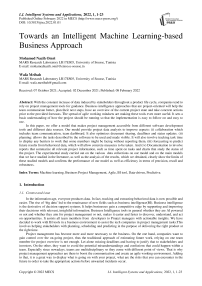Towards an Intelligent Machine Learning-based Business Approach
Автор: Mohamed Nazih Omri, Wafa Mribah
Журнал: International Journal of Intelligent Systems and Applications @ijisa
Статья в выпуске: 1 vol.14, 2022 года.
Бесплатный доступ
With the constant increase of data induced by stakeholders throughout a product life cycle, companies tend to rely on project management tools for guidance. Business intelligence approaches that are project-oriented will help the team communicate better, plan their next steps, have an overview of the current project state and take concrete actions prior to the provided forecasts. The spread of agile working mindsets are making these tools even more useful. It sets a basic understanding of how the project should be running so that the implementation is easy to follow on and easy to use. In this paper, we offer a model that makes project management accessible from different software development tools and different data sources. Our model provide project data analysis to improve aspects: (i) collaboration which includes team communication, team dashboard. It also optimizes document sharing, deadlines and status updates. (ii) planning: allows the tasks described by the software to be used and made visible. It will also involve tracking task time to display any barriers to work that some members might be facing without reporting them. (iii) forecasting to predict future results from behavioral data, which will allow concrete measures to be taken. And (iv) Documentation to involve reports that summarize all relevant project information, such as time spent on tasks and charts that study the status of the project. The experimental study carried out on the various data collections on our model and on the main models that we have studied in the literature, as well as the analysis of the results, which we obtained, clearly show the limits of these studied models and confirms the performance of our model as well as efficiency in terms of precision, recall and robustness.
Machine learning, Business Project Management, Agile, BI tool, Data-driven, Predictive
Короткий адрес: https://sciup.org/15018345
IDR: 15018345 | DOI: 10.5815/ijisa.2022.01.01
Список литературы Towards an Intelligent Machine Learning-based Business Approach
- Alf Abuhajleh. Create dashboards, 2020.
- Atlassian.The first software development tool for Agile teams, 2020.
- Leo Breiman. Random forests.Machine Learning, 45:5–32, 2001.1936.
- Christian Bettinger, Georg Rock, and Anna Schmitt. Glencoe: a tool and a methodology to manage variability within the product development process. International Journal of Agile Systems and Management, 212(4):332–353, 2019.
- Silvia Ceccacci, Marco Matteucci, Margherita Peruzzini, and Maura Mengoni. Multipath methodology to promote ergonomics, safety and efficiency in agile factories.International Journal of Agile Systems and Management, 12(4):407–436, 2019.
- Alok Khatri, D. Garg, and G.S. Dangayach. A comparative analysis of factor analysis model for pinpointing agile developers.International Journal of Agile Systems and Management, 12(2):91–107, 2019.
- S.B Kotsiantis, I.D. Zaharakis, and P.E. Pintelas. Machine learning : a review of classification and combining techniques.Artificial Intelligence Review, 26(3):159–190, 2006.
- M. Lailil and B. Baharum. Document clustering using concept space and cosine similarity measurement.11th International Conference in Computer Technology and Development, pages 58–62, 2009.
- Mohamed Nazih Omri and NourEddine Chouigui. Linguistic variables definition by membership function and measure of similarity.Proceedings of the 14th International Conference on Systems Science, 14(2):264–14273, 2001.
- Mohamed Nazih Omri and NourEddine Chouigui. Measure of similarity between fuzzy concepts for identification of fuzzy user’s requests in fuzzy semantic networks.International Journal of Uncertainty, Fuzziness and Knowledge-Based Systems, 9(6):743–748, 2001.
- Mohamed Nazih Omri. Possibilistic pertinence feedback and semantic networks for goal’s extraction.Asian Journal of Information Technology, 3(4):258–265, 2004.
- Bharat Singh Patel, Atul Kumar Tiwari, Manish Kumar, Cherian Samuel and Goutam Sutar. Analysis of agile supply chain enablers for an indian manufacturing organisation.International Journal of Agile Systems and Management, 13(1):48–59, 2020.
- A. Poulston, Z. Waseem, and M. Stevenson. Using tf-idf n-gram and word embedding cluster ensembles for author profiling. ICLEF 2017 Working Notes, 1866(urn:nbn:de:0074-1866-8), 2017.
- J. R. Quinlan. C4.5: programs for machine learning. CA, USA: organ Kaufmann Publishers Inc.,2616:235–240, 1993.
- Nils Schaetti. Unine at clef 2017: Tf-idf and deep learning for author profiling. CLEF 2017 Working Notes, 281866(urn:nbn:de:0074-1866-8), 2017.
- Monther Sendi, Mohamed Nazih Omri, and Mourade ElAbed. Possibilistic interest discovery from uncertain information in social networks.Intelligent Data Analysis, 21(6):1425–1442, 2017.
- J. Tavčar, J. Benedičič, and R. Žavbi. Knowledge management support in the engineering change process in small and medium-sized companies. International Journal of Agile Systems and Management, 12(4):354–33381, 2019.
- Yasunao Takano, Yusuke Iijima, Kou Kobayashi, Hiroshi Sakuta, Hiroki Sakaji, Masaki Kohana, and Akio Kobayashi. Improving document similarity calculation using cosine-similarity graphs.International Conference on Advanced Information Networking and Applications, 926(Springer):512–522, 2019.
- Ton Tran, Wen Cheng Liu, Bernard K. Chen, Andrey Molotnikov, Xinhua Wu, and Jerome Pun. Ct-based agile 3d printing system for pre-operative planning of orthopedic surgeries.International Journal of Agile Systems and Management, 13(1):1–27, 2020.
- Xuegong Zhang.Using class-center vectors to build support vector machines.Neural Net-works for Signal Processing IX, 1999. Proceedings of the 1999 IEEE Signal Processing Society Workshop, Cat.(No.98TH8468):3–11, 2019.
- Oleg Pursky, Dmytro Mazoha. Architecture Model of Integrated Web-based E-trading Business Process Management System. International Journal of Information Engineering and Electronic Business. 10(2). 1-8, 2018. DOI: 10.5815/ijieeb.2018.02.01.
- Iryna Zavuschak, Yevhen Burov, "The Context of Operations as the basis for the Construction of Ontologies of Employment Processes", International Journal of Modern Education and Computer Science(IJMECS), Vol.9, No.11, pp. 13-24, 2017.DOI: 10.5815/ijmecs.2017.11.02
- Asli Sencer, Meltem Ozturan, Hande Kimiloglu,"A Web 2.0 Supported Business Process Management Environment for Collaborative Research", IJIEEB, vol.7, no.1, pp.8-17, 2015. DOI: 10.5815/ijieeb.2015.01.02


